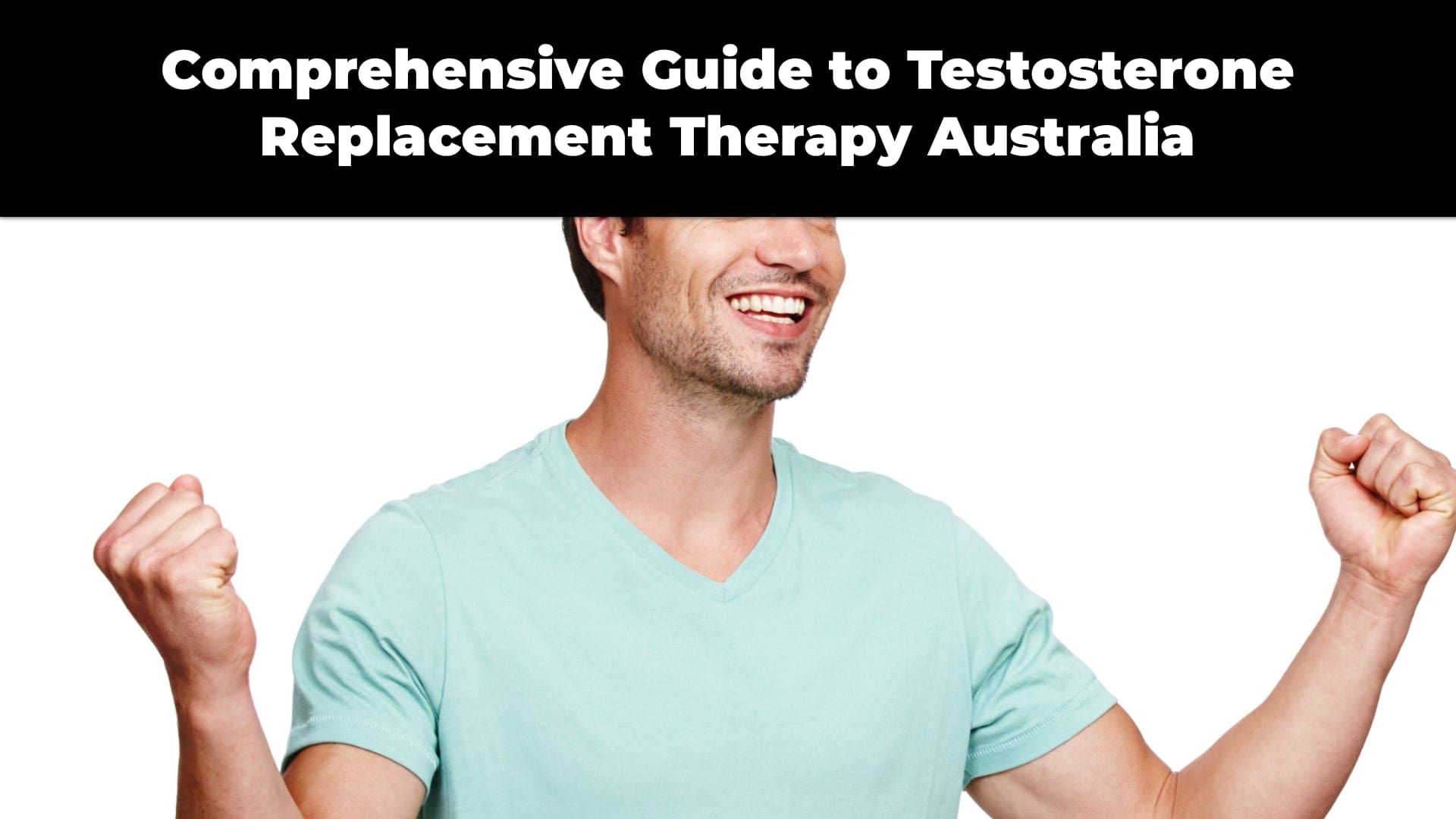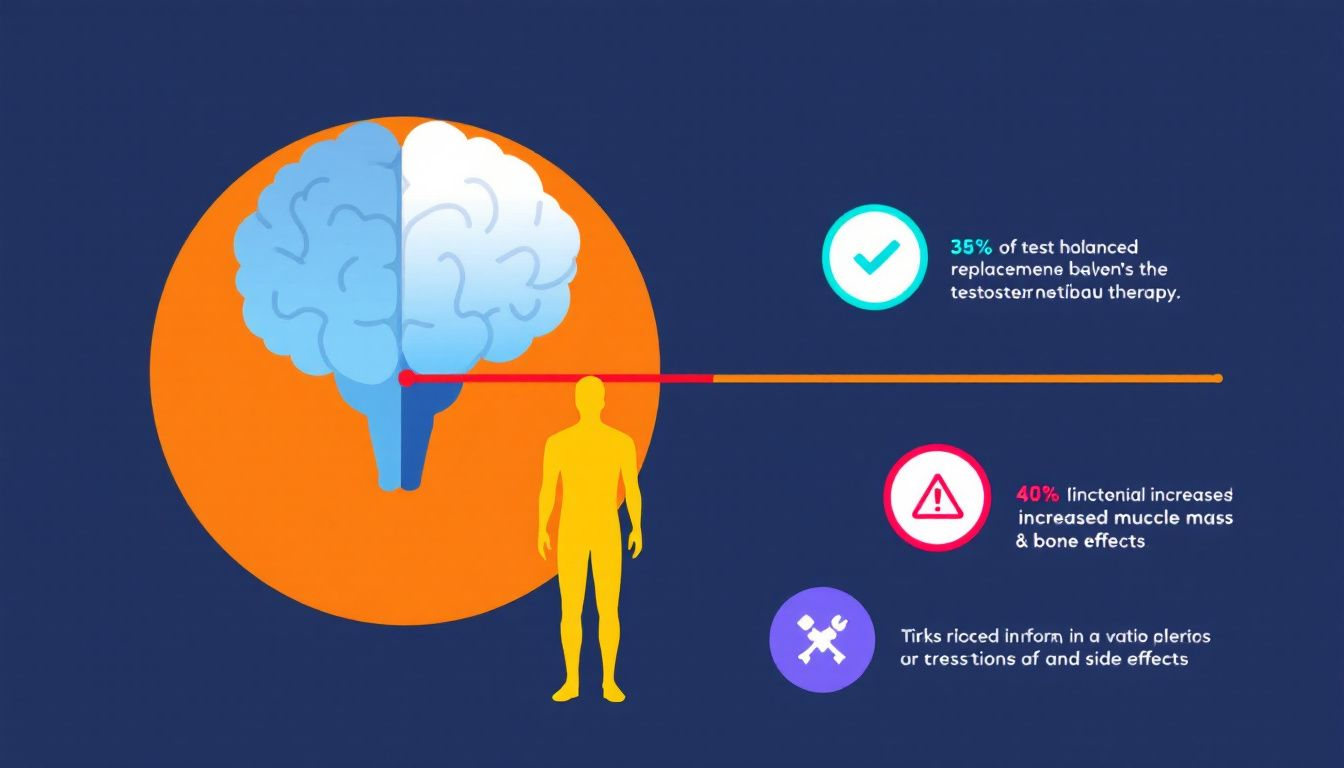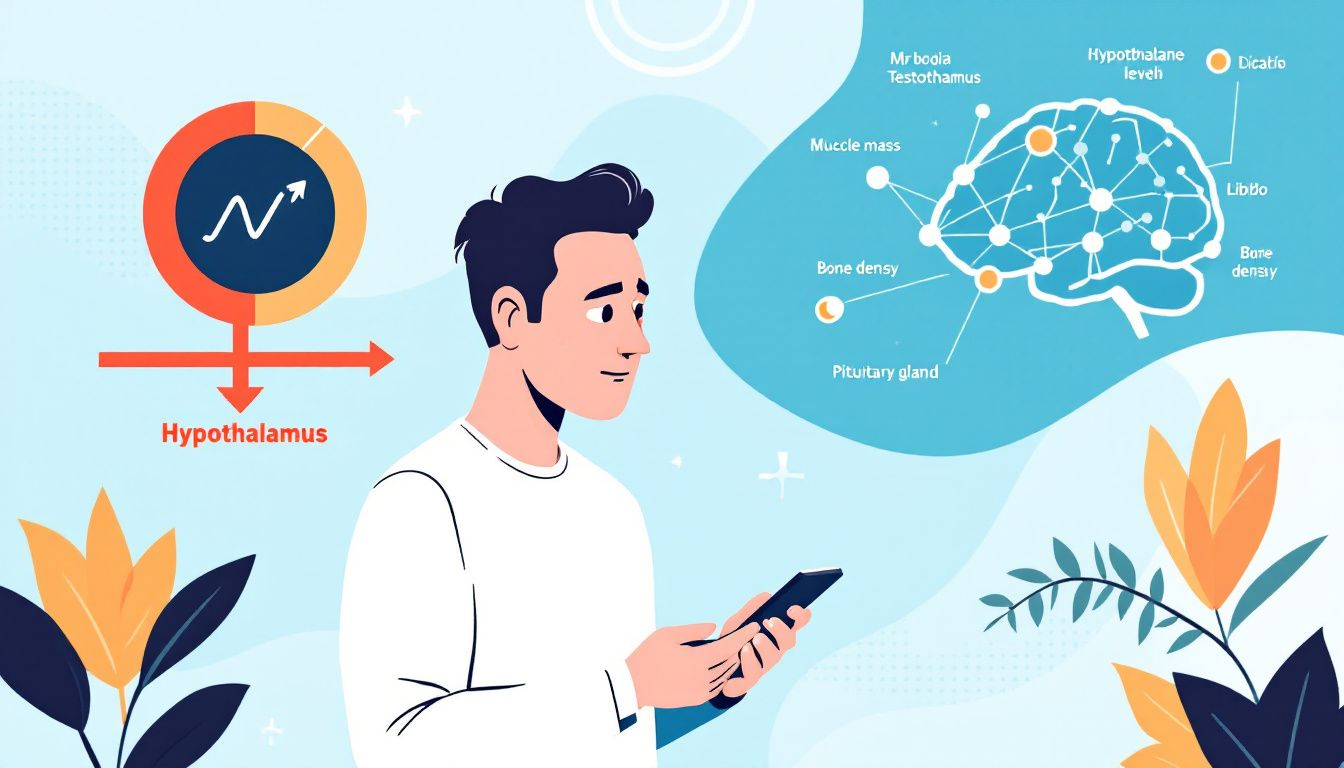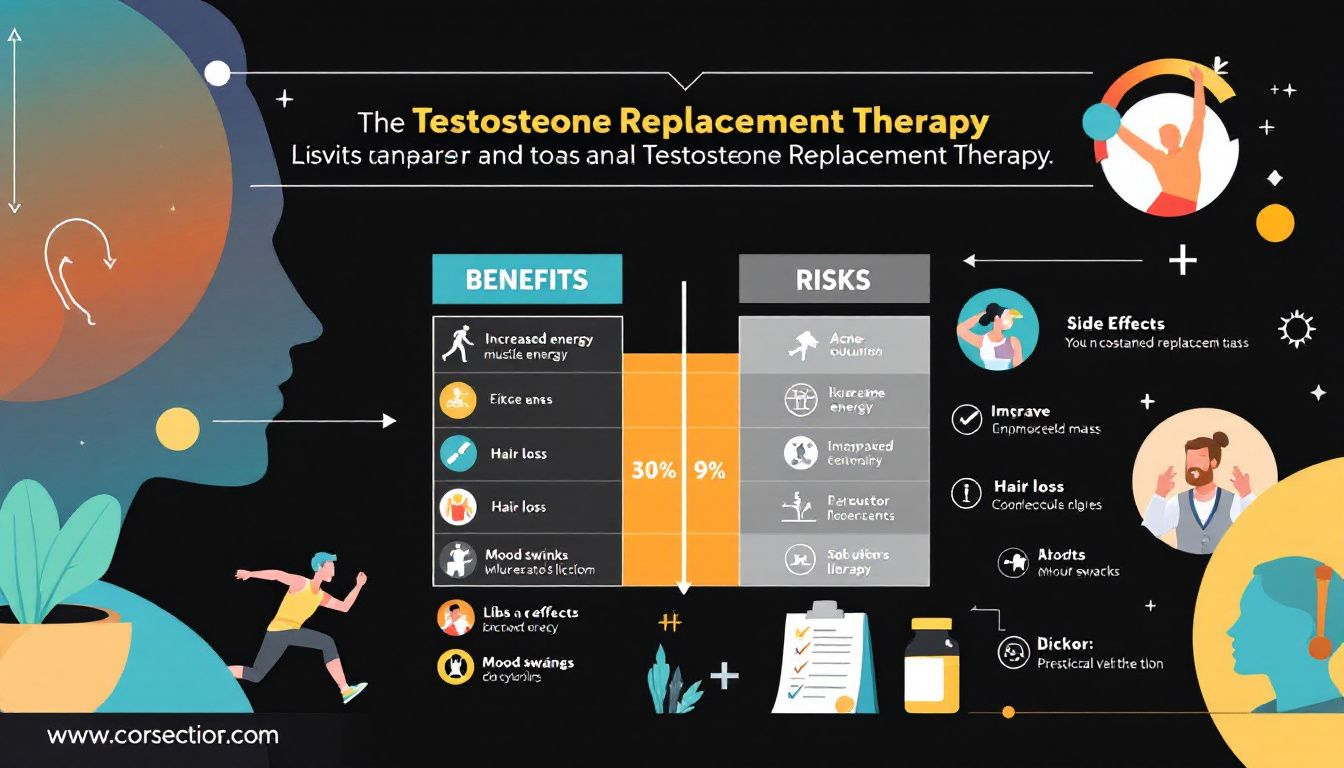
Curious about testosterone replacement therapy Australia? This guide will explain what TRT is, how you can access it, and who might benefit from it. We’ll also cover the benefits and risks.

Testosterone Replacement Therapy (TRT) is a medical treatment designed to address testosterone deficiency in men, a condition often referred to as hypogonadism. The primary aim of TRT is to restore testosterone levels to a normal range, thereby improving vitality, energy, and overall quality of life. In Australia, TRT is available in several forms, including injections, patches, and gels, all of which have been approved by the Therapeutic Goods Administration (TGA). The therapy can be accessed through private clinics and doctors across the country, offering men diagnosed with hypogonadism a chance for complete symptom relief and other health benefits.
TRT is not just about boosting testosterone levels; it’s about enhancing life quality. For many men, this hormone therapy addresses issues that significantly affect their daily activities and mental health. Whether it’s through improving mood and energy levels or addressing specific conditions like erectile dysfunction, TRT offers a pathway to a better life for those struggling with low testosterone levels.
Australian clinics that specialize in testosterone replacement therapy offer a comprehensive suite of services designed to address various aspects of men’s health. These services typically include not only testosterone replacement therapy but also treatments for hair restoration, erectile dysfunction, premature ejaculation, and nutrition counseling. Clinics provide thorough assessments, personalized treatment plans, and ongoing health monitoring to ensure the best outcomes for their patients.
When you visit a men’s health clinic in Australia, you can expect a holistic approach to your health. The clinics are staffed by experienced professionals who understand the complexities of testosterone deficiency and its impact on your life. From initial hormone tests to regular follow-ups, these clinics offer a robust support system to help you navigate your TRT journey effectively.
The popularity of testosterone replacement therapy in Australia has been on the rise, thanks to increased public awareness and the diminishing stigma surrounding low testosterone treatment. As more men become aware of the benefits of TRT, including its potential to protect against age-related health conditions like heart disease and dementia, the interest in this therapy continues to grow. Moreover, the prevalence of hypogonadism, which affects approximately 6% of men, further underscores the need for effective treatment options.
This growing interest is also reflected in the long-term use of TRT. Nearly 40% of men who start testosterone therapy continue with it for at least four years, indicating sustained benefits and satisfaction with the treatment. As the stigma fades and more men seek to address their low testosterone levels, TRT’s role in enhancing men’s health in Australia becomes increasingly significant.

Testosterone replacement therapy is primarily indicated for men diagnosed with low testosterone levels, a condition known as hypogonadism. This therapy can be particularly beneficial for men experiencing low testosterone due to aging, illness, or injury. While TRT can alleviate symptoms of hypogonadism, its efficacy in healthy aging men without a confirmed deficiency remains less clear.
Therefore, a thorough medical evaluation is essential to determine whether TRT is a suitable option for you.
Before:
Recognizing the symptoms of low testosterone is crucial for seeking timely treatment. Common symptoms include persistent fatigue, reduced libido, and mood fluctuations. Erectile dysfunction is another frequent sign, often prompting many men to seek medical advice. Addressing these symptoms through TRT can lead to significant improvements in energy levels, sexual function, and overall quality of life.
After:
Recognizing the symptoms of low testosterone is crucial for seeking timely treatment. Common symptoms include:
Addressing these symptoms through TRT can lead to significant improvements in energy levels, sexual function, and overall quality of life.
Living with low testosterone, also known as testosterone deficiency or hypogonadism, can lead to various health issues. These symptoms can severely impact daily activities and mental health. Treating low testosterone allows men to reclaim their vitality and enhance their overall well-being.
Low testosterone levels can be linked to several medical conditions, making TRT a crucial treatment for many men. Primary hypogonadism, often caused by genetic abnormalities, leads to issues with testicular function. Secondary hypogonadism, more common in older men, indicates problems with the pituitary gland, which controls testosterone production.
Other conditions such as obesity, type 2 diabetes, and metabolic syndrome can also lead to low testosterone levels. Understanding these underlying medical conditions is essential for effective diagnosis and treatment.
By addressing both the symptoms and the root causes of low testosterone, TRT can significantly improve the health and quality of life for hypogonadal men.
Diagnosing low testosterone involves a combination of symptom evaluation and blood tests. Testosterone levels are measured through a blood test, which is the primary diagnostic tool for identifying low testosterone. Measuring hormone levels like LH, FSH, and testosterone is essential before initiating TRT to confirm the diagnosis.
Confirming low testosterone levels with a second test is necessary due to natural fluctuations in hormone levels. Recognizing common symptoms like fatigue and erectile dysfunction can also guide the diagnostic process.
Blood tests accurately measure testosterone levels. These tests should be conducted in the morning, preferably between 8:00 and 10:00 AM, to account for natural fluctuations in hormone levels throughout the day. Accurately measuring total testosterone levels requires at least two blood samples. These samples should be collected on different days.
A hormone test specifically for testosterone deficiency, like the MBS item number 66695, is recommended before starting TRT. Blood tests help measure both total and free testosterone levels, providing a comprehensive view of an individual’s hormone status.
In addition to blood tests, other diagnostic tests may be necessary to provide a complete evaluation of low testosterone levels. CT or MRI scans can identify brain abnormalities that might be affecting testosterone production. Genetic testing may also be performed to identify any genetic problems related to low testosterone levels.
Sperm analysis can assess fertility, which may be impacted by low testosterone. Additional hormone tests are conducted to differentiate between primary and secondary hypogonadism. FSH and LH assessments are part of these tests. These comprehensive evaluations help ensure a precise diagnosis and effective treatment plan.

Testosterone replacement therapy in Australia is available in several forms, each designed to address low testosterone levels effectively. The main types include injections, implants, capsules, gels, and patches. Each form of TRT has its own set of benefits and drawbacks, making it essential to choose the right type based on individual needs and medical advice.
Injectable testosterone is a common form of TRT and includes options like testosterone Enanthate, which is typically administered twice a week to deliver stable testosterone levels. Reandron, a long-acting injectable form, lasts up to 14 weeks, offering the convenience of fewer injections over time.
Standard injections are given into the muscle and can lead to significant fluctuations in testosterone levels. Long-acting injectables like Reandron provide a steady release of testosterone, reducing the need for frequent injections and making it a preferred option for many patients.
Oral testosterone capsules are another form of TRT aimed at restoring testosterone levels in men with low testosterone. These capsules are usually taken two to three times daily with food to enhance absorption.
Oral testosterone capsules have been shown to effectively increase testosterone levels, improve mood, and enhance sexual function in men with low testosterone. This form of therapy offers a convenient and non-invasive option for those who prefer not to use injections or topical treatments.
Topical gels are applied by rubbing them into the skin once a day, providing a steady release of testosterone throughout the day. However, men should avoid physical contact with others for at least four hours after application to minimize the risk of skin transfer.
Testosterone patches are another topical option, generally applied at night and worn continuously to ensure effective hormone delivery. Around 10% of men experience a skin rash with these patches. This reaction is relatively common among users. Despite this, topical gels and patches remain popular due to their ease of use and effectiveness.

Testosterone replacement therapy offers numerous benefits for men with confirmed low testosterone levels. However, it’s essential to balance these benefits against the potential risks. While TRT can significantly improve quality of life, it also carries certain health risks that need to be carefully managed.
The health benefits of testosterone replacement therapy are well-documented. Improved sexual function, mood, and muscle strength are some of the notable benefits. TRT can also alleviate symptoms such as low energy levels and poor sleep patterns, enhancing overall well-being.
Increased testosterone levels can improve bone density, muscle mass, and strength in individuals with low testosterone. These physical health benefits contribute to a better quality of life and increased vitality for men undergoing TRT. Enhanced sexual function and mood improvements have also been noted in men receiving testosterone therapy.
Despite its benefits, testosterone replacement therapy carries potential health risks, particularly concerning cardiovascular issues. Some studies suggest a link between low testosterone and cardiovascular disease, raising concerns about the potential cardiovascular risks of TRT.
There are also concerns that TRT could stimulate the growth of noncancerous prostate tissue and exacerbate existing prostate cancer. Continued research is necessary to fully understand the implications of TRT on prostate health and cardiovascular risks, as the balance between benefits and risks can vary by individual.
Regular monitoring of testosterone therapy is essential to assess symptom improvement and identify any side effects early. Consistent evaluation helps address potential side effects and adjust treatment as needed, ensuring the best therapeutic outcomes.
Routine health check-ups are crucial for assessing testosterone levels, bone density, and overall well-being. After initiating testosterone therapy, patients should undergo evaluations at 3, 6, and 12 months, followed by annual assessments.
These check-ups enable healthcare providers to track testosterone levels and assess related health indicators like bone density. Regular monitoring not only tracks testosterone levels but also monitors potential side effects of therapy.
Physicians may modify TRT regimens based on patient feedback and specific side effects, ensuring optimal therapeutic outcomes. Adjustments are made based on individual patient reactions, such as improvement in symptoms or the occurrence of adverse effects.
Treatment plans are modified based on ongoing evaluations of patient symptoms and laboratory results, ensuring personalized care. This approach ensures that testosterone levels are optimized and any adverse effects experienced during therapy are addressed.

The costs and accessibility of testosterone replacement therapy can vary significantly in Australia. Patients receiving TRT through private prescriptions may incur out-of-pocket costs, which can vary based on the specific medications and dosages prescribed.
However, there are options for financial support through the Pharmaceutical Benefits Scheme (PBS) if eligibility criteria are met.
Private prescriptions for testosterone replacement therapy allow patients to access necessary medications tailored to their specific needs. These testosterone prescribing prescriptions can be obtained from certified healthcare providers who specialize in hormone replacement therapies.
Out-of-pocket costs for TRT can vary significantly based on the type of medication prescribed and the patient’s specific needs. Patients may face substantial costs if they are not eligible for coverage under the PBS or Medicare. Financial assistance options, including subsidies from pharmaceutical companies or non-profit organizations, may help alleviate these costs.
Financial support for TRT in Australia is available through the Pharmaceutical Benefits Scheme (PBS) if patients meet specific eligibility criteria. PBS subsidizes TRT only with evidence of androgen deficiency confirmed by two separate blood tests and a specialist referral. This ensures subsidized treatment is reserved for those with a confirmed medical need.
PBS prescriptions provide significant financial relief, with 70% of TRT prescriptions covered by PBS in 2010. If you are eligible, this can mean near-complete coverage of your TRT costs, making the treatment more accessible and affordable.
Testosterone Replacement Therapy (TRT) in Australia provides a vital solution for men suffering from low testosterone levels. From understanding the various types of TRT available and recognizing the symptoms of low testosterone to navigating the costs and monitoring the therapy, this guide has covered all essential aspects. By restoring testosterone levels, TRT can significantly enhance quality of life, offering benefits that range from improved mood and sexual function to increased muscle strength and bone density. However, it is crucial to balance these benefits against potential health risks and to work closely with healthcare providers for ongoing monitoring and adjustments. With the right approach, TRT can be a life-changing therapy for many men.
To get testosterone prescribed in Australia, you’ll need to see a licensed physician who can evaluate your medical history and blood test results. It’s important that your situation meets the guidelines for testosterone replacement therapy before a prescription is given.
Yes, your GP can test your testosterone levels through a blood test. If you’re concerned, it’s a good idea to discuss this with them for further evaluation.
To boost your testosterone levels, focus on getting enough sleep, exercising regularly, and maintaining a healthy diet. Managing stress and avoiding smoking or excessive alcohol can also make a significant difference.
You may qualify for testosterone replacement therapy if you have symptoms of low testosterone and your blood tests show levels below 300 ng/dl. It’s best to consult your doctor for an evaluation and appropriate testing.
Yes, testosterone injections are legal in Australia, but only when prescribed by a doctor for legitimate medical reasons. Using or distributing anabolic steroids without a prescription is illegal and can lead to penalties.
Copyright 2025 Tongkat Ali Australia, all rights reserved